
Section 12. Thematic reviews
12.4. Hydropower Development in 2020: Global Trends
By Eugene Simonov, Rivers without Boundaries International Coalition (RwB)
This Brief provides a review of hydropower development in 2020 and rich statistics on hydropower in the 21 century. It notes a modest role of hydropower in renewable energy (RE) revolution, global decline in annual hydropower expansion for the last 7 years. Section contains a brief account of relative advantages and disadvantages of hydropower as a part of “sustainable development”. It further assesses national policy environment for current hydropower development in dam-developing countries, exploring violations of internationally recognized ESG standards and safeguards. The report further explores sustainability at project level and contains overview of risks and potential damages for 90% of large hydro put online in 2020. Report has special part on pumped storage technology, possessing promising characteristics, which now faces uncertain future due to higher costs of construction and demonstrated lack of environmental safeguards.
Hydro has a modest role in renewable energy revolution
According to IRENA, in 2020 RE generation capacity increased by 261 GW (+10.3%) and amounted to 2799 GW. Solar accounted for 714 GW with an increase of 127 GW (+22%) and wind energy with 733 GW with 111 GW (+18%), continued to dominate RE capacity expansion, jointly accounting for 91% of all net RE additions in 2020. Hydropower capacity has increased by 20-21 GW (+2%), making global conventional hydropower reach 1211 GW (not counting 121 GW of pure pumped-storage hydropower, which does not produce energy). Addition in hydropower in 2020 amounted to less than 8% of all increase in RE.

Figure 1: 2006-2020 Global annual additions of RE capacity (IRENA)
Global hydropower expansion dynamics
We traced annual expansion of hydropower showing its relative decline during last 7 years. Figure 2.1. omits “pure” pumped storage plants, which are energy storage facilities and do not generate electricity. China has been the absolute champion responsible roughly for half of new hydropower globally and till 2019 displayed the sharpest decline in new hydro. Some increase in 2020-23 is due to completion of several megadams in China (Figure 2.2.). At least till 2018 there was also increase in capacity built with Chinese assistance in other countries. Thus, in 2018-2020 more than 70% of hydropower capacity added globally was installed thanks to Chinese companies and financiers.
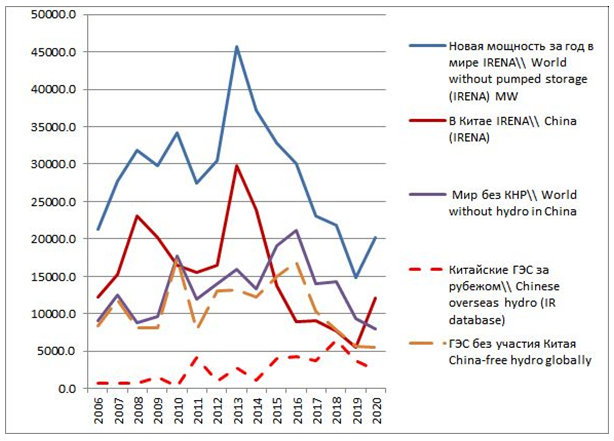
Figure 2.1 Annual globally installed hydropower
(International renewable energy Agency (IRENA))
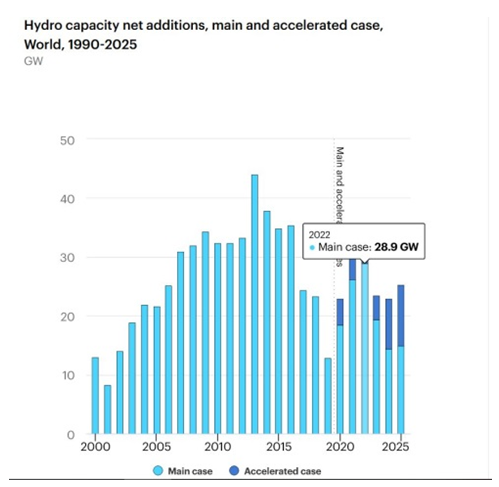
Figure 2.2. Annual globally installed hydropower
(International Energy Agency (IEA) predictions)
From 240 countries reporting on progress in RE to IRENA in 2020: only 46 countries added some hydropower capacity in 2020 (International Hydropower association(IHA) lists only 35 such countries, US Department of Energy (DoE) lists projects under construction in 66 countries as of December 2019); 77 countries reported not having any hydropower (definitely not “energy for all”); 117 countries did not add any new capacity either through greenfield projects or upgrades; in 7 of those capacity decreased. Several countries deliberately removed from plans or restricted new projects (e.g. Bulgaria, Bosnia, Montenegro, etc.). All in all only 25-30 % of countries are developing new hydropower. The pace of greenfield hydropower development (comprising 4-7% of annual additions in new RE capacity) leaves it little chances to make any significant contribution to “the renewable energy revolution”.
According to the US DoE, the global development pipeline by the end of 2019 included 4,545 hydropower projects with total capacities of 414 GW. South Asia and Southeast Asia and Oceania have by far the largest number of projects—more than 600 each—but their average capacity is significantly lower than for the projects in East Asia. In total, at the end of 2019, 117 GW of hydropower were being constructed in 616 projects across 66 countries. China accounted for 55% of hydropower capacity under construction (64 GW). Additionally, there were 297 GW of hydropower in different phases of scoping, permitting, and development.
US DoE claims that if all hydropower and pumped storage hydropower (PSH) investment projects in the global pipeline at the end of 2019 are completed, they represent an estimated expenditure of $1.1 trillion (of those, PSH projects required 270 billion). This total includes investment in new plants as well as expansions (e.g. addition of new turbine-generator units to existing plants) and refurbishments and upgrades (R&U) of existing units. It also includes both projects already under construction and those in the planning and permitting stages.
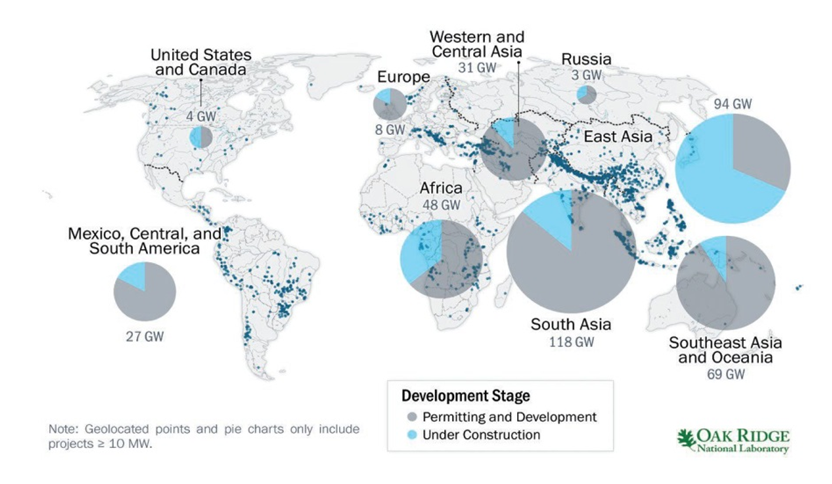
Figure 3. Map of “global hydropower pipeline”
(Source: US DoE, 2021 Hydropower Market Report)
More than 90% of global expenditures are directed toward development of new plants. Tracked capital investment needs in plant expansions and R&U at the end of 2019 totalled $42 and $31 billion respectively. If annual global expenditures for hydropower construction stay at $15-20 billion annually, then fulfilment of existing expansion plans will take 40-50 years. If alternatively we optimistically extrapolate into the future the development pace observed in 2015-2020, then 400+GW may be installed in 20 years. However, it would take 2-5 years to develop similar capacity using wind and solar projects at significantly lower costs.
The future of hydropower expansion is subject to high uncertainty due to many critical factors such as:
• increasing costs per kW installed capacity,
• increasing LCOE (price per KWh) in most countries of the world as opposed to rapidly decreasing LCOE of alternatives;
• much greater cost and time of project construction than for most other RE;
• high likelihood of time\cost overruns;
• acute conflict between hydropower projects and local communities, whose living environmental and resources those projects degrade;
• decreasing availability of suitable sites at rivers located near electricity consumption centers;
• increasing risk of underperformance and catastrophic events due to climate change;
• huge negative impacts on biodiversity and ecosystem functions at planetary scale;
• increasing competition for water resources between all sectors of economy and overarching need to preserve key ecosystem services, that forces to prioritize water-use types, which have no practical alternatives (while hydropower has plenty of viable alternatives virtually everywhere).
• ageing dams around the world with mounting legacy problems and increasing risks of dam failures force responsible governments and companies to prioritize refurbishment and upgrades (and expansion) of existing facilities to greenfield development;
• already high proportion of hydropower in RE fleet in many developing countries makes their energy systems unbalanced and vulnerable to many problems listed above, forcing those states to expand other RE sources to make energy systems more reliable.
At the same time hydropower still has several important selling points:
• ability to provide manoeuvring capacity and other essential services to national energy systems and increasing recognition of their value by energy markets;
• still somewhat lower LCOE compared to most RE sources in some regions and low recurrent costs due to low water prices, lack of lasting compensation mechanisms for environmental and social impacts and, often, disregard to accumulating technical problems;
• corruption-prone model of dam development attractive for officials in countries with defunct governance systems;
• potential for multi-purpose use of reservoirs promises benefits additional to electricity generation, which is often not fulfilled once the dam is built;
• high symbolic value of dams making them focus of national development policies;
• inertia and self-preservation efforts of large construction and equipment-manufacturing industry focused on new hydropower development;
• inertia of multilateral and bilateral development finance institutions which prefer to support “large-scale” investment projects;
• longevity of projects: once built, a large dam may last for 60-120 years;
• highly questionable, but officially widely recognized “low-emissions” status of hydropower, which is partly due to poor accounting of climate-related trade-offs with disruption in ecosystem services and decline in biodiversity and, partly, due to disregard to time-bound climate targets when spreading emissions occurring at initial stages over the full-life-time of the project.
Hydropower still has a huge appeal for variety of influential decision-makers and institutions and has a potential to persist in development agenda, especially in the context of strengthened authoritarian regimes and constrained access to decision-making both for expert community as well as civil society organizations and affected communities.
However even major proponents of hydropower development known for overoptimistic forecasts fully recognize that hydropower development globally has passed its peak and faces decline (Figure 4).
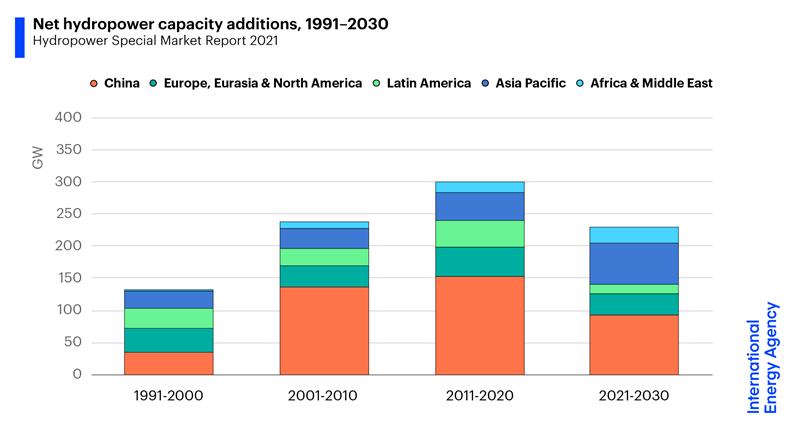
Figure 4. Hydropower statistics by regions and forecast till 2030 by the IEA
Snapshot on hydropower installed in 2020 and trends behind it
Our analysis for 2020 is based on two annual reports: “Renewable Capacity Statistics 2021” by IRENA and “Status of Hydropower Report” by the International Hydropower Association (IHA). We reviewed data on the countries adding more than 100 MW, according to at least one of two reports (Table 1). For either IRENA or IHA version our review covers 90% of capacity installed in 2020.

Table 1. Countries installed more than 100 MW hydropower in 2020
(“Hydropower Champions”)
Notes: “A” marks difference between IRENA and IHA data. X/Y means that X MW was added to a project with Y full planned capacity.
Legend: * marks the countries shifting from overreliance on hydropower;
** marks the countries maximizing hydropower development;
Grey filling - the countries that have recently experienced major economic or political problems due to high reliance on hydropower.
Even among the leading countries hydropower is no longer the preferred type of RE expansion. Hydropower in 2020 contributed only 10% to the RE cumulative additions in all those 21 countries-champions (see Figure 5).
However, real trends differ from country to country. In the table above, we used grey filling to highlight those countries, which had recently experienced major economic or political problems due to high reliance on hydropower (e.g. Georgia and Nepal have extreme seasonal deficit in energy generation forcing them to import energy from neighbours). We asterisked those countries, which despite large hydropower installation are explicitly seeking to move away from overreliance on hydropower (Brazil and Colombia being most recent examples). A double asterisk is used to mark the countries, which pursue the opposite policy of maximizing hydropower development, despite best available evidence on related problems (e.g. Laos strangled by debts related to hydropower construction or Ethiopia risking political isolation due to its neighbours feeling threatened by development on transboundary rivers).

Figure 5. The 21 countries “hydro-champions” in 2020s installed much more solar and wind energy than hydropower (IRENA)
Those divergent trends, likely, will continue in future reinforced by external influences from larger countries and transnational corporations. The countries, which currently have the longest “hydropower pipelines”, are not necessarily those having best technical or financial capacity to build hydro. Two thirds of the top 20 countries planning hydropower (Table 2) heavily rely on foreign hydropower firms, which open possibilities for increase in projects implemented overseas by Chinese, Turkish, Norwegian, Iranian, US, Russian and EU companies.
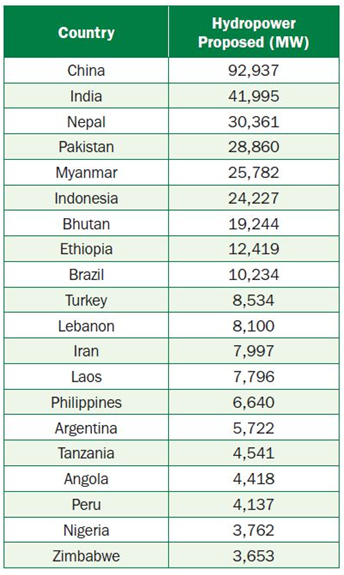
Table 2. Top-20 “hydropower-planning” countries as of January 1, 2020
Source: US DOE, 2021 Hydropower Market Report.
However, those development opportunities are met with growing restraint by international and domestic investors, a trend illustrated below by data on Belt and Road Initiative finance.
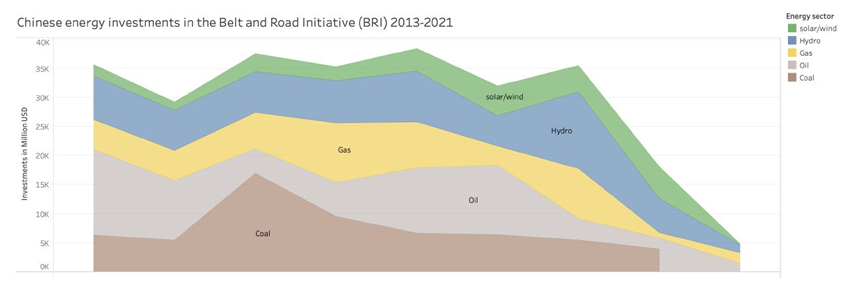
Figure 6. This chart from the China Belt and Road Initiative Investment Report
published in July 2021 by Dr. Ch. Nedpoil Wang (GRBIC) China’s overseas investments
in large hydropower are in sharp decrease
One of reasons for growing restraint in financing hydropower is rapid increase in cost of finance for hydropower, while it is falling for wind and solar.
A study published in April 2021 by Oxford Sustainable Finance Programme showed that over decade the financing costs for coal-fired power plants have increased on average by 38% and for hydropower by 30%, while for wind power and solar PV it was falling. The study also attempts comparison across regions, indicating dramatic rise in costs of hydropower loan servicing in Latin America and relative decrease in ASEAN countries.
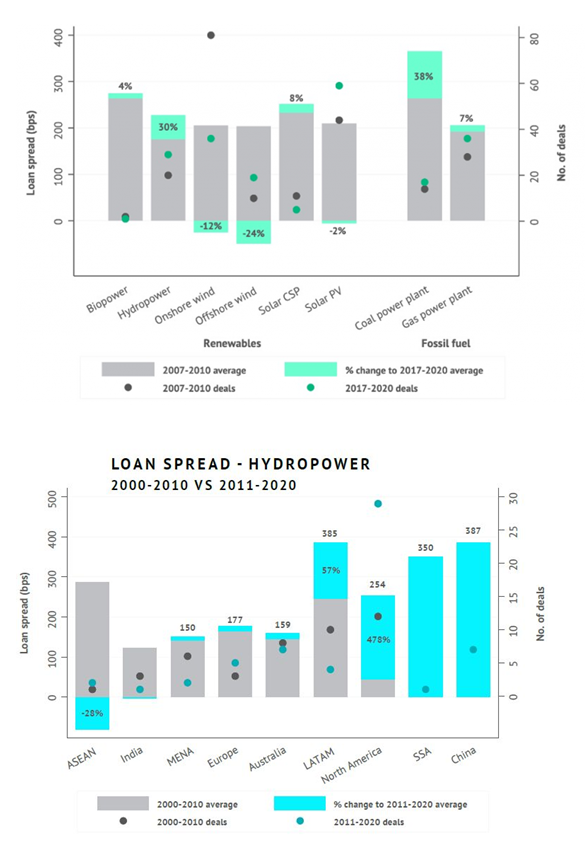
Figure 7. Loan spread graphs show changes in cost of finance in energy sector
Source: Significant fall in cost of financing renewable energy projects. Oxford University
Oxford scientists examine financing costs by analysing syndicated bank loan spreads taken from LPC DealScan, which includes loan information on 12,072 loan deals between 2000 and 2020, involving 5,033 borrowers across 118 countries in the energy and electric utilities sectors as identified by The Refinitiv Business Classification (TRBC). Since the report primarily explores how the cost of debt for fossil fuels and renewables have changed internationally over the past 20 years it provides quite impartial assessment for hydro, since it is marginal to the author’s interests and value judgements focused on fossil fuels.
Increasing attempts of hydropower industry to present hydropower as “green energy” are aiming at reducing cost of finance by granting to dam projects access to “climate finance” and “green bonds” markets. In 2020, the International Hydropower Association succeeded in issuing hydropower standard for “Climate Bond Initiative”, which may give their members access to cheaper money to refinance hydropower projects.
Persistent problems in hydropower development in the champion countries
Unfortunately, modest development of greenfield hydropower in 2020 again came at the cost of destruction of irreplaceable natural areas and suffering of local communities in countries where those dams have been built. It also often exacerbated transboundary tensions, fuelled corruption and economic crisis. Using the River without Boundaries database we examined for which countries championing in 2020 we can present recent evidence of persistent generic problems in hydropower development policies and practices.

Table 3. Hydropower related problems in 2020 hydropower champion countries
For all generic problems we marked by “1” serious threat\problem\impact inside a given country for which we have sufficient evidence within the last decade. Only in case of “transboundary waters conflict” we counted number of neighbours with which this country has a conflict\serious issue related to hydropower impacts . We have evidence on serious unresolved conflicts with local communities, irreversible impacts on biodiversity, damming free-flowing rivers, economic problems caused by hydropower projects for more than 80% of championing countries. Significant transboundary impacts and conflicts are present in 14 countries out of 21 involved 32 additional countries.
China, as usual, heads the rating due to the scale of hydropower construction and 17 major basins shared with neighbours. Laos occupies the second place due to tremendous flaws in its aggressive hydropower expansion policies. India scores high due to its active promotion of domestic hydropower notwithstanding associated damage and acute transboundary water issues. Almost no information is available about Angola, which defines its low ranking. Norway has low ranking due to unique conditions for hydro on its naturally cascading rivers and high domestic governance standards. If we were also taking into account problems\impacts of overseas hydro supported by Norwegian firms and financiers, the scoring would be different.
This simple scoring exercise demonstrates that most of current hydropower development happens in countries not possessing at policy level sufficient safeguards and is associated with very high risks and potential damages. It clearly testifies to the fact that most of hydropower development in the world is unsustainable and proceeds at the expense of key sustainable development objectives.
“Parade of the Champions”: 2020 hydropower expansion in selected countries and its costs
Eurasia
China
Almost two thirds of globally installed hydropower (12.5GW) was added in China, where hydropower capacity reached 370 GW, wind power - 280 GW and photovoltaic - 250 GW. In 2020 most of increase accounts for completion of a giant 10 GW Wudongde Dam and greater addition is expected in 2021-2023 due to completion of the 16 GW Baihetan dam on upper Yangtze River (Jinshajiang). As a result of 50 years of dam building and poorly coordinated development the ecosystem of the Yangtze River is in crisis and many of its 250 fish species face decline and extinction. The giant Chinese paddlefish was recognized as extinct due to dam construction and overfishing. In 2020 China adopted a special law on conservation of Yangtze River, but hydropower companies lobbied to remove prohibition on new dam building, present in early drafts.
Responding to the UNESCO inquiry on hydropower plans near “Three Parallel Rivers of Yunnan” protected area, China confirmed that damming plans for Lancang (Mekong) and Jinsha (Yangtze) rivers will proceed “as planned”, which means further encroachment into fragile mountainous areas and retention of greater water volume in reservoirs with detrimental effects for downstream ecosystems. In late 2020 China also revealed a plan to develop 60 GW hydropower dam in Tibet on Yarlung Tsangpo (Brahmaputra) River right before it leaves for India and Bangladesh. Such plans create extreme tensions between countries and may destroy traditional lifestyle of indigenous minorities.
In 2020 China installed 48 GW of photovoltaics and 73 GW of wind capacity. The annual increase from wind power generation exceeded that from hydropower despite extreme floods on major rivers of the country. Already having the greatest hydropower fleet China, obviously, could substitute new hydropower construction by less destructive alternatives, but it still plans building new dams on transboundary watercourses to strengthen its strategic advantage over downstream neighbours.
Turkey
With 2.5GW added capacity, Turkey holds the second place in hydropower installation in 2020, largely due to putting in full operation the infamous Ilisu Dam on the Tigris River. The project blocks the Tigris River, destroying important biodiversity and displacing up to 50,000 people, the majority of whom are ethnic Kurds. It submerged the ancient town of Hasankeyf, one of the world’s oldest continuously inhabited settlements and threatens water security of Iraq as well as the Mesopotamia Marshes World Heritage. Turkey repeatedly creates artificial water scarcity to pressure and intimidate its downstream neighbours in Syria, Iraqi Kurdistan and Southern Iraq. In Syria this led to dysfunction of hydropower plant on the Euphrates.
Lao DPR
Laos put on line phase II dams of the Ou River cascade, the Nam Ou #1, 3 and 4 dams. The cascade has been developed under a Build-Operate-Transfer (BOT) arrangement, and PowerChina will operate the dams for 25 years before handing them back to the Laos State Electricity Corporation (EDL). The construction of the dams has been controversial for the loss of biodiversity and sources of food in the river basin. Resettlement is also an ongoing, difficult process, even according to Lao media reports. Hydropower cascade on the Ou River together with Luang Prabang Hydro being built on the main stem of Mekong also may negatively affect the Luang Prabang World Heritage city at the confluence of those two dammed rivers.
Altogether, the country installed in 2020 anywhere from 0.5 to 1.3 GW in the Mekong River basin, which unique ecosystem it purposefully destroys in an attempt to become the “battery of Southeast Asia”. However, instead of a triumph, the country in 2020 faced prospects of a debt-default and declining demand for its energy from irritated riparian neighbours. In 2020 Laos was forced to cede the EDL into concession to a China Southern Grid Co. This demonstrates that over-development of hydropower mega-projects may lead to partial loss of sovereignty by smaller states.
India
In January 2021 Minster of Energy of India declared that the reason for delay in hydropower construction is civil society movements sabotaging development of the country…
India, according to both IRENA and IHA, installed 480 MW or less than 3% of 20 GW it hopes to add by 2030. However, India’s own official statistics shows addition only of 399 MW. The largest new facilities put on-line were the 300 MW Kameng HEP in Arunachal Pradesh, a project associated with significant corruption, fraud and massive cost\time overruns. Another addition – the 99 MW Singoli Bhatwari Hydro - comes with questionable environmental clearance and is also facing a tunnel leakage issue. This project was massively damaged in the June 2013 Uttarakhand disaster, which, unfortunately, has not served a lesson to responsible agencies. In 2020 - early 2021 many people were killed in several accidents, greatest of them being a new catastrophic landslide in Uttarakhand, affecting many dams under construction in an area which scientist long before declared off-limits of large infrastructure development. The IHA reports that the Government also granted approval to proceed with the giant Dibang project (2,880 MW), which is predicted to cause major destruction of biodiversity and violation of human rights.
Responding to a “Covid-19 vigil” initiated by the Prime Minister of India, who encouraged households to switch their lights on and off, hydropower producers had to ramp down and up within seconds to support the unprecedented 31 GW shift in electricity demand. Fortunately this reckless authoritarian experiment has not caused any major failures, but it has not been effective in preventing spread of COVID either.
Indonesia
With a pledge to reach 23% of RE share by 2030 the Indonesian government has clearly disadvantageous focus on hydropower, which creates many new conflicts with biodiversity conservation objectives and well-being of local communities. Among 236 MW added in 2020 the largest project is 120 MW “Poso Peaker Hydro” on the island of Sulawesi, where the company belonging to the family of the former Vice-President Joseph Kalla is degrading the unique ancient lake Poso – a cradle of freshwater biodiversity and depriving local communities of their traditional fisheries and cultural monuments. On the island of Sumatra the government vehemently supports construction of a Batang-Toru Hydro by Zhefu Holdings and Power China-Sinohydro, which may wipe-out newly-discovered ape species –Tapanuli orangutan from the only known habitat.
Pakistan
In 2020 Pakistani military construction company started cooperation with Chinese SOEs and consortium of western consultants-enablers to develop the Diamer Basha Dam, which is the largest and likely the most controversial project in the transboundary Indus River basin. A 100 MW Gulpur Project was completed on the Poonch River, was once considered the most ecologically sensitive river in the Azad Jammu & Kashmir, which makes a dam siting in a Masheer national park completely not justifiable. Nevertheless the IFC, ADB and other international players heavily invested in this private-public partnership project and claimed that resulting design helps to achieve “net biodiversity gain in critical habitat” (based on condition “if everything goes as prescribed”). This bad precedent provided excuse for further sacrifice of similar “critical habitat” in the Kunhar River near Balakot City, where in 2020 loan were granted by the ADB and AIIB to finance construction of a 300 MW hydropower plant.
Nepal
Nepal likely has the largest ratio of stalled hydropower projects per unit GDP. It was hit hard by COVID-19 lockdown, because it depends heavily on Chinese and Indian labor and technology to build hydro. Hydropower construction severely affects indigenous people of the mountains and charismatic wildlife, including freshwater Gangetic dolphins. The country is trapped by hydropower lobby that effectively prevents diversification in solar and other RE badly needed by local economy.
Georgia
Georgia added a 178MW Shuakhevi Hydro, developed by Norwegian “Clean Energy Invest” and Indian “Tata-Power”. Actually this plant was completed in 2017, but collapsed right after the start of operations due to malfunction of the plant’s derivation tunnels, which pass through local villages. At least three other projects collapsed or failed during the last decade. Poorly planned projects stalled by popular wrath dot the landscape, but the government moves on marketing new river stretches to new foreign developers. The latest massive protest campaign against the Namakhvani dam cascade built by the same Norwegian company and Turkish firm ENKA on Rioni River has resulted in halt in construction in March 2021 and 30000-strong anti-government manifestations in the city of Kutaisi located downstream from the planned dam. This construction also has potential conflict with a World heritage property downstream.
Austria
According to IRENA, Austria installed 550 MW, from those 333 MW came in mixed hydro\pumped storage facilities. In 2020 WWF-Austria and other groups protested against illegal construction of the Tumpen-Habichen Power Plant built on the free flowing Otztaler Ache River, which started in secrecy under cover of Corona virus curfews, while legal complaints were still pending.
Albania
Norwegian Statcraft completed the 197 MW Moglice project as a part of a cascade on one of the last free-flowing rivers of Europe. The European Commission urged the country to diversity its power portfolio, saying its dependence on hydropower could have severe consequences for the power supply during times of drought. After the Energy Community sent a legal inquiry on the HPP Pocem project awarded to a Turkish Company without a tender, the Albanian Government withdrew permits for all hydropower projects on the free-flowing Vjosa River and said it plans to integrate the area into the Vjosa national park.
Africa
Guinea
Guinea installed 225 MW at the Souapiti Hydropower Project located on the Konkoure River, with a total installed capacity of 450 MW. This project was constructed by China International Water & Electric Corporation (CWE - subsidiary of China Tree Gorges Group) and is expected to cost about $2 billion. According to a report by the Human Rights Watch the dam’s reservoir will ultimately displace an estimated 16,000 people from 101 villages and hamlets. It will flood 253 square kilometers of land, including an estimated 42 square kilometers of crops and more than 550,000 crop-bearing trees. Displaced populations will have less favorable land than they have been farming for generations and dozens of already displaced residents interviewed by the Human Rights Watch say that they are already struggling to find adequate food for their families. Meanwhile, a failure to expand capacity of the transmission line connecting Souapiti and Kaleta with Conakry has left large amounts of new generation stranded and Electricite de Guinee experiences difficulties in returning loans to Chinese banks.
Ethiopia
In Africa Ethiopia is a champion in building hydropower that destroys key natural assets and community livelihoods on transboundary rivers. It connected to the grid 254 MW Genale Dawa III, financed by Chinese banks and assisted by Chinese contractors (somehow the IHA reported it twice in 2019 and 2020). The dam will entail significant impacts on Somalia, severely restricting flows into Somalia’s Juba River. The Juba is one of only two perennial rivers in Somalia, and it accounts for most of the country’s agricultural production. The Genale Dawa III is expected to reduce the Juba’s flows by between a quarter and a third, with major consequences for Somalia’s food security.
The Grand Renaissance Dam (6,000 MW) on the Nile completed the first stage of filling its reservoir in July 2020 with 4.9 billion cubic meters of storage and threatens both Egypt and Sudan, who actively develop international coalition to press Ethiopia to commit to a legally binding agreement on the amount of water retained in the reservoir and schedule of downstream flows.
In Kenya a Lake Turkana was put on the “World Heritage in Danger” List due to destructive impacts from a dam built by Ethiopia on Omo River and in 2021 UNESCO still requests in vain Ethiopia and Kenya to jointly present a Strategic Environmental Assessment and develop safeguards against further degradation.
The Americas
Colombia
The country is best known for the 2.4 GW Hidroituango project, which was developed on the free-flowing Cauca River with rampant violations of human rights and multiple murders of local activists. Construction was stalled in 2018 by a giant landslide, creating threat of dam failure, which caused displacement of 12,000 people from downstream settlements. The IHA Report notes that the Inter-American Development Bank in 2020 approved an extra US$900 mill. to salvage/finish the Ituango project, while Export Development Canada publicly stated they regret participation in financing this dam. Following this incident Colombia revised its energy development program to avoid overreliance on hydropower, thus we doubt accuracy of the IRENA report of 680 MW of new hydro. However, in 2021 placement of wind farms proceeds with violations of indigenous peoples’ rights similar to those in case of the Ituango project.
Chile
Chile by January 2021 connected to grid the 251 MW Alto-Maipo dam built by US AES Corporation with many violations of community rights, which may jeopardize Santiago’s drinking water to benefit a mining tycoon. In July 2020 the Independent Consultation and Investigation Mechanism concluded in its report on the Alto-Maipo Hydroelectric Project that the Inter-American Development Bank (IDB) breached its policies, since the company implementing the project failed to: carry out any assessment of gender-differentiated impacts, despite the large number of workers brought into the Maipo River Valley; evaluate the impacts of the project on recreational uses of the river; and assess the impact of the project on cattle drivers, among other issues. Decision comes too late to serve justice to communities affected by this ill-designed project.
Canada
The Lower Churchill Dam, the 1st phase of the Muskrats Falls Project in Labrador entered textbooks on environmental risks long before its first turbine was connected to grid. The project that is billions over budget and years behind schedule, at a final forecast will cost more than $13 billion. Local Inuit people resisted the flooding by the 834 MW dam arguing it will contaminate the area with methylmercury. The company continued with the project and flooded the 41-sq-km reservoir. The Innu Nation of Labrador announced on October 6th 2020, that it is seeking $4 billion in damages from Hydro-Quebec over this mega-dam. The suit, filed in the Supreme Court of Newfoundland & Labrador, seeks compensation for the theft of ancestral Innu land in 1967 to build the Churchill Falls hydro-electric project. Another prominent case in Canada is “Site C” hydropower construction progressing on the Peace River in British Columbia that will greatly increase disruption of flows to the Wood Buffalo World Heritage site and lands of indigenous people. After a request from the World Heritage Committee the Government of Canada completed a strategic environmental assessment, which confirmed detrimental effects, but failed to undertake decisive steps to prevent damage.
Honduras
Honduras and Sinohydro Co. have put in operation the 106 MW Patuca III Hydro, which for a decade has been of outmost concern due to its potential impact on Rio Platano World Heritage site that was recognized as “Heritage in Danger”. In early 2020 Honduras reported that the Patuca III HPP has been completed to 97% and the reservoir was filled at 81,3%. In 2021 the World Heritage Center noted with serious concern and regret that construction of the Patuca III HPP is now essentially completed without a proper assessment of the current and potential impacts of the project on the World Heritage property. It requests that a strategic environmental assessment to be urgently expedited to assist putting in place the necessary measures to mitigate adverse impacts on the property.
Besides that, Honduras is widely known as a country where hydropower builders employ assassins to get rid of local activists. The story of indigenous Lenca leader, Berta Caceres assassination has become widely known globally, but it has not stopped the local practices. Twelve indigenous and environmental activists were killed in 2020. The last victim Cerros Escalante, shot on March 22 2021, led a local group called “Communities United,” was active in hamlets near the Rio Ulua and opposed the El Tornillito hydroelectric dam.
United States
The only sizeable new plant we could discern in the USA was the 36 MW Red Rock Hydroelectric Project mounted on pre-existing dam. So, likely, the rest from 157 MW reported by IRENA came from upgrades and expansion of existing hydro. Statistics shows that hydro makes about 0.4% (by capacity) in new electricity project pipeline at the end 2020, and proposed pumped storage makes less than 2% of storage projects in the pipeline, with 98% occupied by batteries.
The projects listed above together make up 90% of global hydropower installation in 2020 . Hardly 10% of projects put on-line do not have notable flaws, which make them inherently unsustainable and dangerous. Exactly the same trend was observed about projects completed in 2019 in the review presented in the Rivers for Recovery Report. Thus we see perpetuation of unsustainable pattern of destructive hydropower development without effective attempts by the industry to stop it.
Welcome the pumped storage…
As for the pumped storage hydro (PSH), much hyped as a remedy for grid stability and flexibility, which also usually has less destructive footprint, only 1633 MW were put in operation in 2020, despite all hopes trumpeted by hydropower industry and personally by former Australia PM Malcolm Turnbull. In practice this means that most countries balance uneven output of ‘variable renewables” by other means ranging from building batteries to smart use of large grids (See Hydropower Market Report with such analysis for the US hydro and PSH).
A map published by the US DoE shows the global PSH pipeline as traced by US Oak Ridge Labs (Figure 8). The global development pipeline by the end of 2019 included 284 PSH projects with total capacities of 226 GW. At the end of 2019, according to the US DoE, 13 countries were constructing 50 PSH projects with total capacity of 53 GW. Additionally, there were 173 GW of PSH in different phases of scoping, permitting, and development.
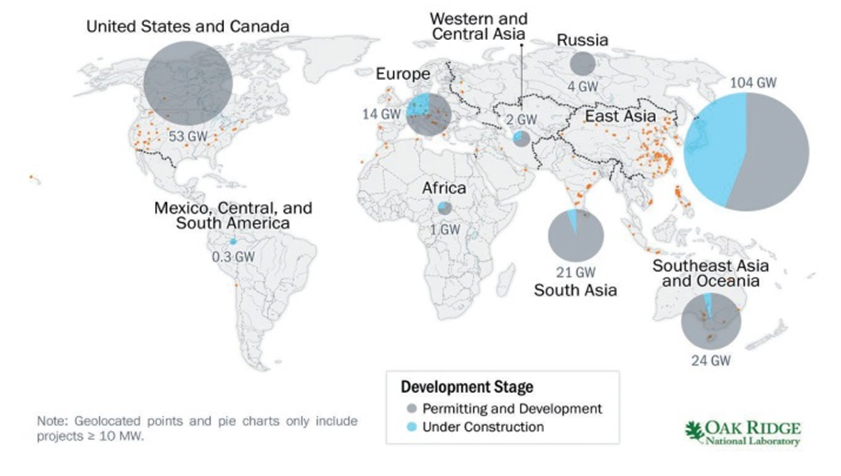
Figure 8. Map of global PSH pipelines
Source: US DoE, 2021 Hydropower Market Report
Almost everyone agrees that in principle the PSH is the most promising of all hydropower technologies. Researchers from the Australian National University developed geographic information system algorithms to catalogue potential closed-loop PSH sites around the world. In 2019, they published a global atlas of the 616,000 locations identified in their analysis, with a combined energy storage capacity of approximately 23 million GWh. Although only a small portion of the identified sites would ultimately be viable once more detailed geological and environmental studies are conducted, the authors estimate that developing as few as 1% of the identified energy storage capacity would be enough to fulfill the storage requirements of a global grid with 100% renewables. However, something is preventing the PHS from developing at pace corresponding with needs of RE development. An average 2.3 GW was developed annually since 2005 without any increase (Figure 9).

Figure 9. PSH installation over last decade has been uneven
Source: US DoE, 2021 Hydropower Market Report
China accounted for 87% of PSH planned capacity with 46 GW under construction. Only 1.2 GW were installed in 2020 as three turbines at the Jixi Pumped Storage in 2020. China’s 13th year plan is ending with completion of less than 40% of planned 35 GW expansion of PSH fleet. China PSH pricing mechanism released in April 2021 suggested all pumped storage plants in China to adopt a two-part tariff mechanism based on capacity and energy tariff after 2023.
Other 300 MW was installed in northern Israel at Gilboa PSH and, according to IRENA, 115 MW were added in the United States.
As for environmental and social impacts, relatively few concerns have been voiced in relation to the PSH projects. Decades ago Russia proposed a 1 GW PSH in Tver Region which would negatively affect the Tsentralno-Lesnoy Strict Nature Reserve, but that proposal long ago faded away without a trace. Australian PM Turnbull authorized an irresponsible scheme of 2 GW PHS development called Snowy-2, based on existing hydro inside the most iconic Kosciusko National Park of Australia, which was planned and pushed through EIA without credible mitigation measures. Now this unfortunate development will serve as repellent for investors into this otherwise benign technology. Project pipeline advertised by investors includes new large PSH projects presenting high unassessed potential threats, such as “Battery of the Nation” Scheme encircling Tasmania Wilderness World Heritage Site in Australia and several dams proposed on indigenous lands upstream of Grand Canyon World Heritage in the USA.
Less than 2 GW of PSH added globally in 2020 may signify that this technology is still less attractive than battery and grid-based solutions to boost energy system flexibility. Given fresh experience with the irresponsible Snowy-2 project civil society and environmental organisations, would be less eager to speak in support of this technology. To regain popular support the pumped hydro proponents need to adopt the strictest environmental and social standards, especially for site-selection planning process, and demonstrate in practice that this technology enables RE revolution without destruction of nature and does not present just another unsustainable business as usual.
Conclusion
This report demonstrates that most of current hydropower development happens in countries not possessing at policy level sufficient safeguards and is associated with very high risks and a potential damage, which is vividly exemplified by 90% of large hydro put online in 2020. Financial viability of hydropower projects has been rapidly decreasing due to increasing construction and energy production costs as well as increase in cost of capital. Climate resilience of existing hydropower fleet happened to be lower than expected with many countries suffering from overreliance on hydropower in times of droughts and large floods. The industry is still trying to overcome difficulties by exploiting “climate” theme in an attempt to capture cheaper climate finance and has made some progress with support of the “Climate Bonds Initiative”.
Pumped storage hydropower technology, despite its promising characteristics, faces uncertain future due to higher costs of construction and lack of environmental safeguards displayed by its flagship project “Snowy-2” in Australia. However, closed-loop pumped storage built outside of sensitive natural areas still has a chance of revival, given vast choice of potential locations available on each continent. It is unlikely to regain credibility unless its environmental and social impacts are subjected to analysis and public discussions from early stages of project identification.
Key references
International Rivers and RwB 2020. Rivers for Recovery Report.
US DoE, 2021 Hydropower Market Report.
International Hydropower Association 2021. Status of Hydropower Report.
IRENA 2021. Renewable Capacity Statistics 2021
Oxford University 2021. Significant fall in cost of financing renewable energy projects.